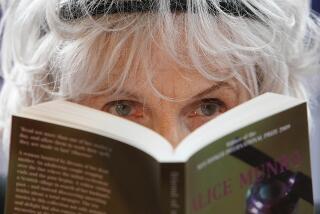The Ties That Bind
- Share via
At first, Alexandra Styron’s novel “All the Finest Girls” seems like a picture woven of antique brocade, carefully constructed sentences, well-chosen adjectives, but then the individual strands of thread spin out into individual stories, well-defined colors, each with a different voice, so that it becomes a piece of finely woven, almost delicate, tapestry.
Briefly, it is the story of Adelaide Abraham, a young woman who grew up in Connecticut, summered in a big house on an exclusive, seemingly protected shore, the obvious comparisons to her own life could be drawn but seem meaningless in terms of Styron’s achievement.
Addy works at a museum in New York restoring antique paintings, most recently retouching a piece that she feels she has made too vivid by her restoration, which is almost a metaphor for her telling of this story. She has recently had a breakdown on the heels of a breakup, although it’s possible she had a breakdown years before, and it has only now surfaced in order that she may heal.
Louise (called Lou), the Caribbean woman who raised her, who in present times would be called a nanny but in those times would more aptly be referred to as a nurse, has just passed on. Lou was her only shelter from her parents’ unhappy marriage and her own dark, primitive, almost untamable side. And Addy decides to “take a leave” and go to the island of St. Clair for Louise’s funeral.
The book weaves effortlessly between scenes set on St. Clair and Addy’s memories of her own island summers, as she pieces together the tragic events of Louise’s life. Louise abandoned her own children, after being abandoned by their father, a wildly romantic, attractive singer who briefly held a seat in the island’s Parliament. Lou and he never married, and, in a way, it was to escape their tortured love that Lou moved to the cultured shelter of Connecticut and summers on the shore, which must have been as foreign to her as St. Clair is to Addy.
“All the Finest Girls” is a searing portrait of a generation, whose notions of parenting were obscured by their own self-obsessed lives, unconscious of the effects on their children, almost as if they and their children lived in separate worlds. And yet, at night, it is as if the walls between the bedrooms dissolve, and the child is subjected to alcoholic, abusive rantings and a bird’s-eye view of a relationship she cannot comprehend. It is no wonder that Addy the child is terrified of a cat that howls “like a dying witch when [her] father shouts at [her] mother.” At one point she resorts to cutting herself because pain has become so familiar.
In a way, the least successful section of the book is the most haunting, an incident on St. Clair when Addy dances with someone inappropriate, even toys with the idea of going off with him, and her behavior throws into the forefront Lou’s grown sons’ feelings toward her, their resentments of her, that she is, in a way, an interloper. She has, in this moment, been thrust into a situation in which she does not know how to behave and forgets, as she did so many times as a child, that there are and should be restraints on her, that proper conduct is a requirement.
As she learns more about Lou’s life, interspersed with her childhood memories, Addy comes to understand what it must have been like for Lou to leave her children, and realizes that Lou’s own feelings of loneliness and abandonment perfectly mirror hers.
Styron’s finest achievement is her ability to glide seamlessly between the dialect of St. Clair and the cultured language of Connecticut, in well-pitched almost contrapuntal tones, as she pieces together the fragments of each of these women’s lives.
As Addy lays Lou to rest, she also lays her own childhood memories to rest, and she learns to accept that we are where we come from, that blood ties are indelibly strong and that the events of our lives make us what we are.
More to Read
The biggest entertainment stories
Get our big stories about Hollywood, film, television, music, arts, culture and more right in your inbox as soon as they publish.
You may occasionally receive promotional content from the Los Angeles Times.










